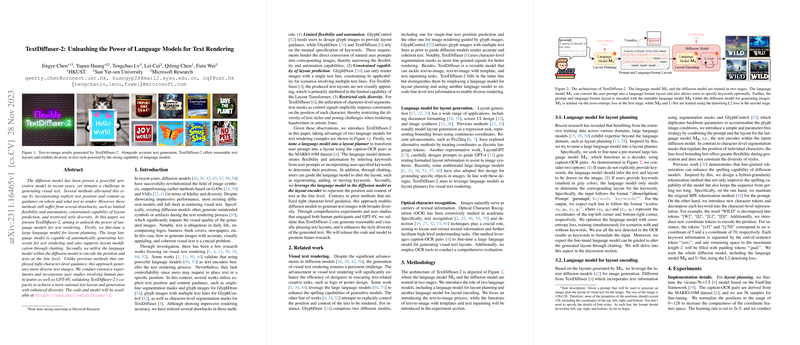Introduction to TextDiffuser-2
Diffusion models have shown promising results in image synthesis, but their application to visual text rendering—creating images that contain text—has been challenging. Problems like unintended symbols and a lack of aesthetic layout are common. Text plays a major role in various contexts such as logos, banners, and book covers. Overcoming the difficulties in generating visual text that is not only accurate but also visually appealing is therefore an important step forward.
Related Work and Challenges
Prior research has made strides in visual text rendering. Incorporation of LLMs as text encoders has shown benefits. Some methods employ explicit guidance mechanisms for the placement and content of text. However, these have several limitations including lack of flexibility, limited layout prediction capabilities, and constrained style diversity. TextDiffuser-2 distinguishes itself by employing two LLMs--one for layout planning and another for line-level layout encoding which allows for more diverse text styles.
Methodology Behind TextDiffuser-2
TextDiffuser-2 trains two LLMs: the first transforms user prompts into layouts for text positioning and the second helps in encoding this layout information within a diffusion model. A significant improvement in this system is the method for encoding the position and content of texts at a line level instead of character level, which results in a richer variety of text images. Another focus was on optimizing the LLM to generate the correct layout with user-provided keywords or even to modify these layouts interactively through a chat interface.
Experimental Validation and Applications
Extensive experiments showed that TextDiffuser-2 produces rational layouts and a broader range of text styles, confirmed through both user studies and quantitative measures. It can perform text-to-image generation automatically, extract keywords efficiently, and offer a flexible, interactive way to modify layouts through conversation. A variety of applications also showcased TextDiffuser-2's adaptability, including generating images with templates, performing text inpainting tasks, and creating images without any text content.
Conclusions and Future Directions
TextDiffuser-2 presents a significant leap in visual text rendering, overcoming previous constraints and enhancing style diversity without sacrificing text accuracy. It does struggle with complex language texts due to character set limitations. The model's capability opens up new possibilities for creative industries and educational applications. Looking ahead, further exploration in multi-language character rendering and improved resolution of text images could be beneficial. While there is a risk of misuse in creating false information, the overall positive impact it can bring to design and education is noteworthy.
